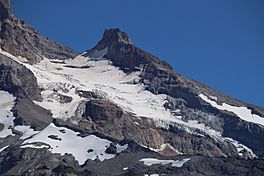Reid Glacier (Oregon) facts for kids
Quick facts for kids Reid Glacier |
|
|---|---|
 |
|
| Type | Mountain glacier |
| Location | Clackamas County, Oregon, United States |
| Coordinates | 45°22′15″N 121°43′08″W / 45.37083°N 121.71889°W |
| Area | 126 acres (51 ha) (2004 estimate) |
| Length | .75 mi (1.21 km) |
| Terminus | Ice fall |
| Status | Retreating |
Reid Glacier is a mountain glacier found on the west side of Mount Hood in Oregon, USA. This glacier sits at elevations from about 9,800 feet down to 6,000 feet. It is an important natural feature because it is the starting point for the Sandy River.
Contents
What is Reid Glacier?
Reid Glacier is what's left of much larger glaciers that existed during the last ice age. Imagine huge sheets of ice covering the land! This glacier is a smaller piece of that ancient ice.
Where is Reid Glacier Located?
The glacier is surrounded by other interesting natural features. To its north, you'll find Yokum Ridge, which also forms the southern edge of Sandy Glacier. To the south, another ridge separates it from Zigzag Glacier. The higher, eastern parts of this southern ridge include a famous rock formation called Illumination Rock. The very top part of the glacier is just below a steep, narrow valley known as Leuthold Couloir. Reid Glacier is entirely located inside the protected area called Mount Hood Wilderness.
What Are Crevasses?
The upper parts of Reid Glacier are known for having many crevasses. A crevasse is a deep crack or split in a glacier. These cracks form when the ice moves and stretches, especially over uneven ground. They can be very deep and are a natural part of how glaciers behave.
Is Reid Glacier Changing?
Yes, Reid Glacier is changing, just like many glaciers around the world. Between the years 1907 and 2004, the glacier lost about 35% of its total surface area. This means it became much smaller.
How Far Has the Glacier Shrunk?
The end of the glacier, called the glacier terminus, has also moved back a lot. Over the same time period (1907 to 2004), the terminus retreated by about 1,607 feet (or 490 meters). This shows that the glacier is getting shorter and melting away.


